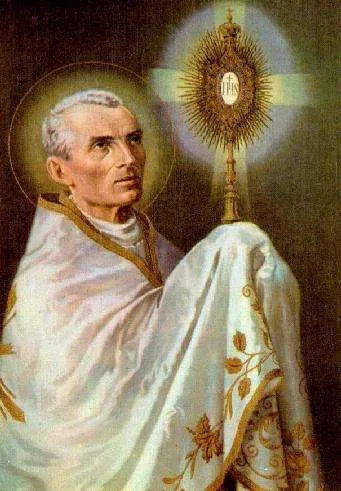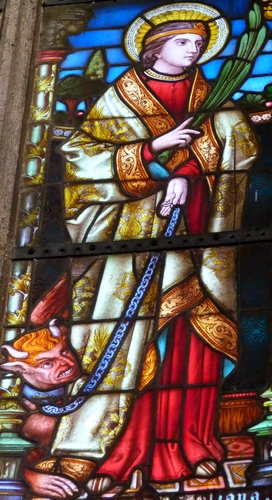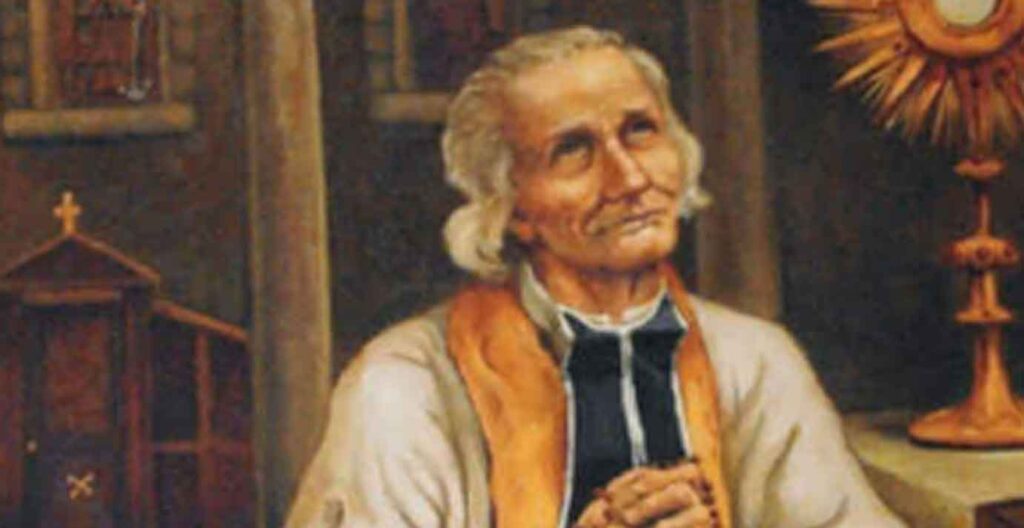1811–1868; Invoked for an increase of devotion to the Holy Eucharist; Canonized by Pope John XXIII in 1962
Peter Julian Eymard was born to devout parents and was the youngest of ten children, eight of whom died in infancy. His mother, especially devout, taught him the faith well. From an early age, Peter developed a profound devotion to the Blessed Mother and the Eucharist. His devotion to the Blessed Mother was intensified as a child when he made a pilgrimage to the Marian shrine of Our Lady of Laus, where the Blessed Mother had appeared to a young shepherd girl a century earlier. Peter’s love for the Eucharist also began at a young age. One story relates that, at the age of five, Peter was missing from home. He was found in the local church standing next to the tabernacle. When his sister asked what he was doing, he reportedly said, “I am near Jesus and I am listening to him!” Another story relates that before Peter received his First Holy Communion, he would eagerly await his sister’s return from Holy Communion and would place his head on her heart and say, “I can feel His presence!” Finally, when he received his First Holy Communion at the age of twelve, he promised Jesus he would become a priest. His love for our Eucharistic Lord was so intense that he could consider nothing else.
In his teenage years, Peter asked his father to allow him to become a priest, but his father initially refused. His father, an artisan who made cutlery, wanted Peter to work in the family business, especially since Peter was his only surviving son. As a result, Peter studied Latin in private to prepare himself for eventual theological studies. In 1827, when Peter was seventeen years old, his father finally consented and Peter began to study under a hospice chaplain near Grenoble, about twenty miles from his home. The following year, his mother died and Peter returned home, partly due to his mother’s death, partly to help his father, and partly because the priest-chaplain did not teach him Latin as promised.
In 1829, at the age of nineteen, Peter moved about 150 miles south to Marseille, France, where he entered the Oblates of Mary Immaculate. Five months later, Peter became seriously ill and had to return home again. In 1831, Peter’s father died. Peter left the family business, traveled back to Grenoble, and was reluctantly admitted to the diocesan seminary. Though he was a bit behind in his education, his zeal got him through, and he was ordained a diocesan priest on July 20, 1834, at the age of twenty-three.
As a newly ordained priest, Father Peter suffered from some health problems but was eventually able to serve as a parish priest in the countryside. In 1839, after sensing a call to religious life, he joined the Society of Mary (Marist Fathers) and a year later was assigned to the Marist College of Belley where he fulfilled the duties of preaching, religious instruction, administration of the sacraments, and acted as a liaison with pupils and parents. After four years, Father Peter was appointed Provincial of the Society of Mary and made Visitor-General. As Visitor-General, he traveled to various Marist houses to inspect their health and fidelity to the Marist mission. At the age of thirty-eight, during a visit to Paris in 1849, Father Peter came in contact with a group called the Association of Nocturnal Adorers, whose mission was to practice and promote perpetual adoration of Christ in the Eucharist. This was a life-changing experience for him and the beginning of the rest of his life’s work. After some missteps, perhaps due to excess zeal, Father Peter was demoted from his position within the Marists and sent to the Marist College at La Seyne-Sur-Mer, where he served from 1851–1855. This was a period of prayerful discernment for him, and the desire began to grow within him to found an order dedicated to the Blessed Sacrament. In 1856, despite initial strong resistance from his Marist superior, Father Peter received permission to leave the Marists and found the Congregation of the Blessed Sacrament, a new congregation dedicated to Eucharistic adoration and the fostering of this devotion.
Upon leaving the Marists, Father Peter was joined by another priest named Father Raymond de Cuers. They traveled to Paris where they sought the approval of the Archbishop of Paris. After a twelve-day hearing, conducted by the archbishop and two other bishops, the three unanimously offered their support, agreeing that his mission was the will of God. They encouraged Peter and his order not only to promote Eucharistic adoration but also to catechize adults and prepare them for Holy Communion. Before the end of the year, despite being dirt poor, Father Peter and Father de Cuers had moved into a run-down house they rented from the archdiocese, began raising money to build a chapel that he called a “cenacle,” and welcomed two other priests and a novice as his congregation’s first members. The congregation’s purpose was the salvation of souls and fostering devotion to the Eucharist. Their works were preaching, offering retreats, and preparing people for their First Holy Communion through catechesis. By the beginning of 1857, they opened their chapel for adoration three days a week, and a few people came. However, within a few months, Father Peter became ill, the two priests and novice left, the archdiocese wanted the rented property back, and Father de Cuers left but returned a day later.
Though the establishment of this new congregation proved to have many difficulties, Father Peter pressed on, moved to a new location, and began again. This time he and Father de Cuers added catechesis to their ministry, exposed the Blessed Sacrament, invited the poor and the sinner to repent, adored Jesus, and encouraged frequent reception of Holy Communion. Over the next nine years until his death, Father Peter worked tirelessly on his God-given mission. As members joined, he opened up additional houses, began a contemplative branch of his order for women called the Servants of the Blessed Sacrament, started the Priests’ Eucharistic League, intended for diocesan clergy to help them grow in and spread a love for the Eucharist, and formed a lay organization to share their mission called the Archconfraternity of the Blessed Sacrament.
When Father Peter began his work, he sensed the need to make reparation through adoration for sins committed against our Lord. As time went on, his focus included reparation but also expanded to adoration purely for the love of God and as a means to make a gift of oneself to God.
As we honor this great saint, ponder your own devotion to Christ in the Holy Eucharist. Saint Peter Eymard discovered the holiness of God, hidden behind the appearance of bread and wine. His devotion to adoration led him to catechesis about the Eucharist. Allow him to inspire you to renew your own commitment to learning more about the Blessed Sacrament, so that you will more fully give yourself to our Lord as a total gift of yourself, out of love for God, the reparation of sin, and the salvation of souls.
Source: https://mycatholic.life/saints/saints-of-the-liturgical-year/august-2—saint-peter-julian-eymard-priest/







